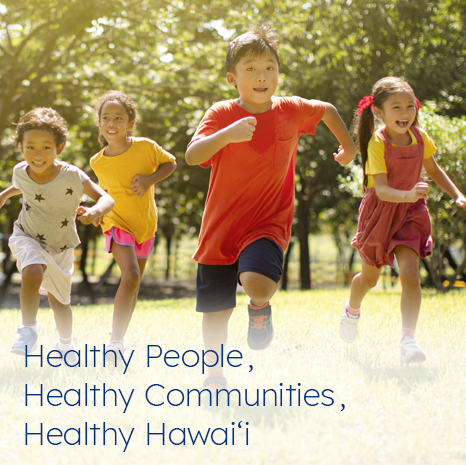Your message has been forwarded to our team and we will respond to you shortly.
The Hawaiʻi Diabetes Plan (HDP) 2030 represents a coordinated effort between stakeholders and partners throughout the state who worked together to develop objectives and strategies that utilize data, best practices, and evidence-based science. The resulting HDP 2030 reflects a common vision for preventing and managing diabetes to help the people of Hawaiʻi, especially those most at-risk, lead healthy lives.
Diabetes is a serious chronic health condition that can increase a person’s risk for serious illness and death. More than 7 million Americans with diabetes have never been diagnosed, potentially missing out on essential healthcare for their disease. People with uncontrolled diabetes may experience blindness, kidney failure, heart attack, or stroke. Uncontrolled diabetes also puts a person at greater risk of serious complications from the flu and COVID-19. The current obesity epidemic has largely contributed to the rapidly increasing rates of diabetes and prediabetes.
- Filipinos
- Native Hawaiians
- Other Pacific Islanders
Health disparities are prevalent in diabetes and many chronic diseases. In Hawaiʻi, Filipinos, Native Hawaiians, and Other Pacific Islanders are at greater risk of developing diabetes.28
The HDP 2030 incorporates principles of the Social Ecological Model and is organized into four sector areas: Community Design and Access, Education, Health Care, and Worksite. The plan prioritizes goals, objectives, and strategies that lead to policy, systems, and environmental change. Objectives were developed using current data, best practices, and evidence-based science, and reflect one or more cross-cutting themes.
The HDP 2030 is meant to be a living document that is reviewed and updated throughout the plan’s timeframe. Implementation of the plan will be a collective effort by individuals and organizations across the state.
Establish at least one fully recognized National Diabetes Prevention Program site in the State of Hawaiʻi that provides online or distance learning.
- Support new organization(s) with the capacity to deliver the Diabetes Prevention Program (DPP) virtually or via telehealth by facilitating and maintaining access to necessary technology
- Provide technical assistance to organizations in obtaining distance and hybrid National Diabetes Prevention Program (NDPP) CDC recognition
- Connect referring organizations to distance learning DPP sites
Establish at least three new American Diabetes Association recognized or Association of Diabetes Care and Education Specialists accredited Diabetes Self-Management Education and Support sites.
- Support new organizations seeking recognition or accreditation by covering the application fees on a once-in-a-lifetime basis and providing technical assistance
- Collaborate with American Diabetes Association, Association of Diabetes Care and Education Specialists, and local Diabetes Self-Management Education and Support (DSMES) sites to provide training and mentoring to new organizations
By 2025, identify at least six Health Information Technology priorities to enhance population health.
- Identify key Health Information Technology (HIT) partners to establish a HIT workgroup
- Convene HIT workgroup regularly to identify the HIT priorities to enhance population health
Implement at least 3 Health Information Technology priorities.
- Implement priorities identified by the HIT workgroup (e.g., telehealth, remote patient monitoring, use of clinical decision support tools, use of population health management, use of patient portals or engagement and education resoures, Artificial Intelligence)
By 2025, identify at least five measurable outcomes indicative of team-based care and monitor over time.
- Identify key partners to establish a team-based care workgroup
- Convene team-based care workgroup regularly to identify measurable outcomes indicative of team-based care
Implement at least 3 team-based care priorities.
- Implement priorities identified by the team-based care workgroup (e.g., use of pharmacists in medication management to increase physical patient panels, use of non-physician workforce for Asthma Self-Management (ASME) and other chronic disease prevention and management, or use of Community Health Workers (CHW) in patient care coordination, use of school health aides and school-based health services, and expansion of academic programs and professional development)
Implement a statewide, comprehensive worksite wellness recognition program that at least 10 very small-, 15 small-, 10 medium-, and 5 large-employers will participate in.
• Identify partners and convene an advisory group to develop a Hawaiʻi-specific, evidence-based worksite wellness recognition program that includes the following areas:
o Asthma
o Cancer
o Diabetes
o Heart Disease and Stroke
o Physical Activity and Nutrition
o Tobacco
• Pilot the recognition program with a group of diverse employers and modify the program based on their feedback.
| Baseline | Target | Status Date- 07/01/2025 | |
|---|---|---|---|
| Very Small | 0 | 10 | 0 |
| Small | 0 | 15 | 0 |
| Medium | 0 | 10 | 0 |
| Large | 0 | 5 | 0 |
| Activities | Responsible Parties | Completed By |
|---|---|---|
| 1. Convene an advisory group to develop a Hawai‘i specific, comprehensive WSW recognition program that will include all aspects of health | HIPHI; AlohaCare; HMSA; Kaiser; UHA Health Insurance; DOH | 2024 |
| 2. Pilot recognition program with a group of diverse employers | HIPHI; AlohaCare; HMSA; Kaiser; UHA Health Insurance; DOH | 2025 |
| 3. Establish infrastructure for program at the DOH, statewide | DOH | 2025 |

The long-term measures are broad measures that help assess progress toward achieving the Healthy Hawaiʻi Vision 2030.